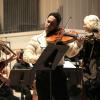
The San José Chamber Orchestra concert at St. Francis Episcopal Church on Sunday, Nov. 12 featured two fairly recent compositions for string orchestra that were otherwise profoundly different. One was short, the other long; one was vigorous and a bit crazed, while the other was a vast sea of contemplation. This only summarizes the gulf between them.
Stacy Garrop is an American composer who sees herself as a storyteller. In her words, her work Inner Demons “depicts a man as he loses his mind.” It presents a sequence of themes, finishing with the folk song “The Wayfaring Stranger,” here played in a familiar style filled with double stops by concertmaster Liana Bérubé. Then, Garrop starts to run her themes together, as if they were being melted down in a saucepan over medium-high heat. The rising screeches that distract from “The Wayfaring Stranger” and the ensuing chaos as the themes flow into each other convey the intended confusion without being themselves confusing.
More than anything, this music is weird — and wonderfully so. Music Director Barbara Day Turner and the orchestra gripped this piece tightly and did not let go. The sound was crisp, bright, and shining, an excellent interpretation.
That occupied the first 15 minutes of the program. The remaining 45 were taken up by the unbroken expanse of a cello concerto by the late British composer John Tavener. A devout Orthodox Christian, Tavener was one of the most spiritually intense composers in a generation full of them: Arvo Pärt and Henryk Górecki are his best-known colleagues. Tavener’s The Protecting Veil is, by his own description, a religious icon to the Virgin Mary, carved in sound instead of painted on wood. Like an icon, it’s not meant to go anywhere or do anything but exists to be contemplated.

This makes the piece totally unlike a typical concerto focused on achieving a whip-sharp conclusion. It needs a brave cellist with lots of gumption who can play 45 continuous minutes — for the cellist represents Mary and is never silent for more than a long breath — of not greatly variable or action-filled music and make it interesting, even captivating. At this concert, that cellist was Evan Kahn, principal with SJCO as well as several other local ensembles.
The work opens with the cello playing long held notes at the very top of its range. The composer directs these to sound “transcendent, with awesome majesty.” This would be easier if they were not so very high as to make it difficult to hold the pitch steady.
As the music expanded down the cello’s range, Kahn revealed a welcome variety in his playing. While his upper range has a thin but warm tone, his middle range is darker, and he emits a real growl near the bottom. He never failed to hold the notes together as a melodic line, no matter how slow their succession, and he provided a few moments that felt like true spiritual breakthroughs. He held the stage by himself when the orchestra was silent for “The Lament of the Mother of God at the Cross,” which has the cello muted.

When the string orchestra is playing, it mostly holds quiet sheens of still notes, often in the form of dissonant chords that are so gently played as not to be harsh. These are interrupted by passages in which Tavener intends to convey the loud ringing of bells but which are so cacophonous as not to carry that image. In the course of the work’s eight sections, there are a couple portions where the music gets fast and exciting for a bit, representing “The Annunciation” and “The Resurrection.” But the still, quiet dissonance predominates, finally changing to lush supporting harmonies at the depiction of “The Dormition” (peaceful death) of Mary.
Listeners might not have been spending this time worshipping along with Tavener, but at least this journey through a largely static musical landscape succeeded at being stimulating and absorbing. Kahn, Turner, and the orchestra took this large assignment and completed it with credit.



